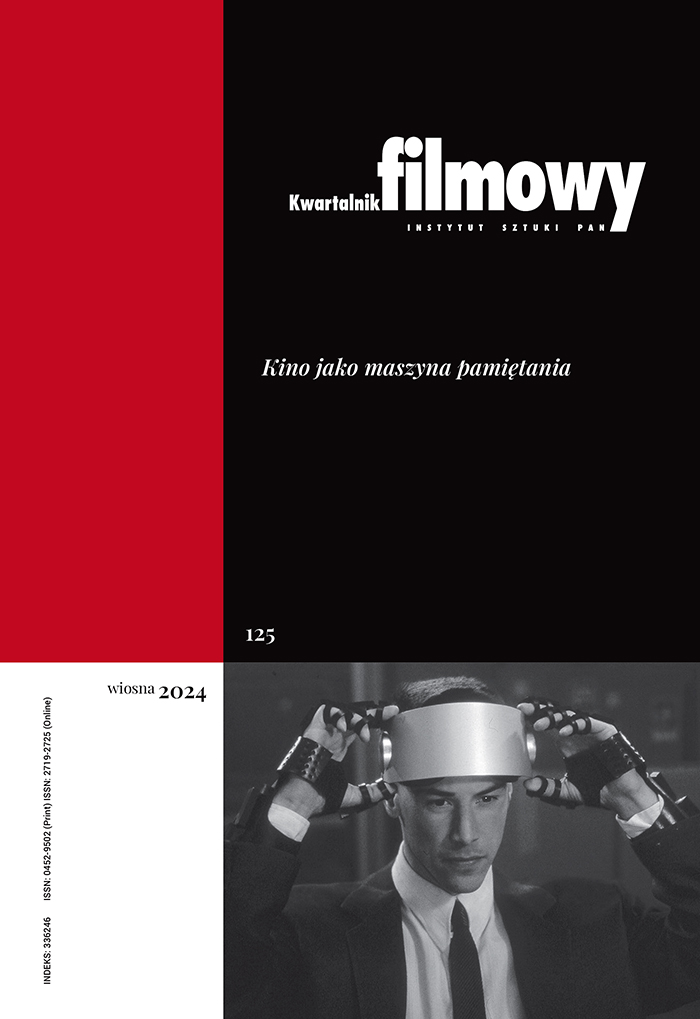Przeszłość i przyszłość, czyli przestrzenie możliwego. Przyczynek do badań nad kinem jako wehikułem czasu
Abstrakt
Kino w swej istocie i z uwagi na swą funkcję jest wehikułem czasu par excellence. Elektroniczna telewizja i wideo zróżnicowały jeszcze tę właściwość, zagęściły ją i poszerzyły, z jednej strony przez możliwość dostarczania wydarzeń do daleko położonych miejsc w formie obrazów i dźwięków jednocześnie (telematyka), z drugiej przez techniczną interwalizację mikroelementów transmitowanych sekwencji czasowych. W trybie elektronicznym czasowa strukturyzacja nie dotyczy jednak już tylko relacji między pojedynczymi kadrami czy półobrazami, ponieważ tu obrazy w sensie strukturalnym powstają z olbrzymią prędkością. To powoduje, że w tym wypadku również nie może być mowy o kontynuacji. Konstruowanie obrazów elektronicznych odbywa się stale, lecz w sposób przerywany. Uświadomienie sobie technologicznego wymiaru filmu jako maszyny czasu korespondowało z rozwojem charakterystycznych dla danego okresu dramaturgii, w ramach rozmaitych ruchów awangardowych po II wojnie światowej. Nowa jakość audiowizualnych wehikułów czasu powstała wraz z pojawieniem się gier komputerowych. Decydująca była integracja odbiorcy danej historii z ciągiem narracyjnym i dramaturgicznym, zmiana paradygmatu, dzięki której z obserwatora przeistacza się on w uczestnika. Film zyskał status produktu codziennej konsumpcji, nie jako rzeczywistość wirtualna [virtual reality], lecz rozszerzona [expanded reality], w której gracz stawał się współaktorem.
Słowa kluczowe:
wehikuł czasu, telematyka, rzeczywistość wirtualna, rzeczywistość rozszerzonaBibliografia
Bartels, Klaus. 2000. Erinnern, Vergessen, Entinnern. Das Gedächtnis des Internet. W: T. Hensel, H.U. Reck, S. Zielinski (red.). LAB, Jahrbuch für Apparate und Künste. Köln.
Google Scholar
Chown, Marcus. 2002. Backwards to the Future. „New Scientist” 2.
Google Scholar
Czernobrow, Wadim A. 1996. Experiments on the change of the direction and rate of time motion. nieopublikowany rękopis. Moskwa.
Google Scholar
Deleuze, Gilles. 2008. Kino. 1. Obraz-ruch 2. Obraz-czas. Tłum. J. Margański. Gdańsk.
Google Scholar
Herbert, Nick. 1990. Nur Werner allein hat die nackte Realität gesehen: Vorschlag für eine wirklich „Neue Physik”. W: G. Hattinger, M. Russel, Ch. Schöpf, P. Weibel (red.). Ars Electronica 1990, t. 2, Virtuelle Welten. Linz.
Google Scholar
Metz, Christian. 1966. La grande syntagmatique du film narratif. „Communicationes” 8.
DOI: https://doi.org/10.3406/comm.1966.1119
Google Scholar
Zielinski, Siegfried. 2013. […After the Media] News from the Slowly Outfading Twentieth Century. Minnesota.
Google Scholar
Zielinski, Siegried. 1988. Laufen Sie um Ihr Leben. Das Geschäft mit den Telespielen. „Medien Concret” 1.
Google Scholar
Zielinski, Siegfried. 2012. […nach den Medien] Nachrichten vom ausgehenden 20. Jahrhundert. Berlin.
Google Scholar
Zielinski, Siegfried. 1985. Zur Geschichte des Videorecorders. Berlin.
Google Scholar
Autorzy
Siegfried Zielinskikwartalnik.filmowy@ispan.pl
Universität der Künste w Berlinie Niemcy
Pofesor teorii mediów oraz archeologii i wariantologii mediów na berlińskim Universität der Künste; piastuje funkcje „Michel Foucault Professor” w zakresie techno-estetyki i archeologii mediów w European Graduate School w Saas Fee (Szwajcaria) oraz dyrektora Vilem Flusser Archiv w Berlinie. Autor licznych publikacji, redaktor serii Variantology: On Deep Time Relations Arts, Sciences, and Technologies (2005-2011). Członek Nordrhein-Westfälische Akademie der Wissenschaften und der Künste, berlińskiej Akademie der Künste, a także European Film Academy, Magic Lantern Society of Great Britain, Kuratorium w ramach Zentrum für Kunst und Medientechnologie w Karlsruhe.
Statystyki
Abstract views: 276PDF downloads: 166
Licencja
Prawa autorskie (c) 2014 Siegfried Zielinski

Utwór dostępny jest na licencji Creative Commons Uznanie autorstwa 4.0 Międzynarodowe.
Autor bądź autorka udziela wydawcy niewyłącznej i nieodpłatnej licencji (CC BY 4.0) na wykorzystanie tekstu w „Kwartalniku Filmowym”, zachowuje nieograniczone prawa autorskie i zobowiązuje się do podawania miejsca pierwodruku przy ponownym wykorzystaniu artykułu (umowa licencyjna do pobrania). Czasopismo jest wydawane na licencji CC BY 4.0. Zgłaszając artykuł do publikacji, autor bądź autorka wyraża zgodę na jego udostępnianie na tej licencji.
W wydaniach od 105-106 (2019) do 119 (2022) wszystkie artykuły były publikowane na licencji CC BY-NC-ND 4.0. W tym okresie autorzy i autorki udzielali(-ły) niewyłącznej i nieodpłatnej licencji (CC BY-ND 4.0) na wykorzystanie tekstu w „Kwartalniku Filmowym”, zachowywali(-ły) nieograniczone prawa autorskie i zobowiązywali(-ły) się do podawania miejsca pierwodruku przy ponownym wykorzystaniu artykułu.











